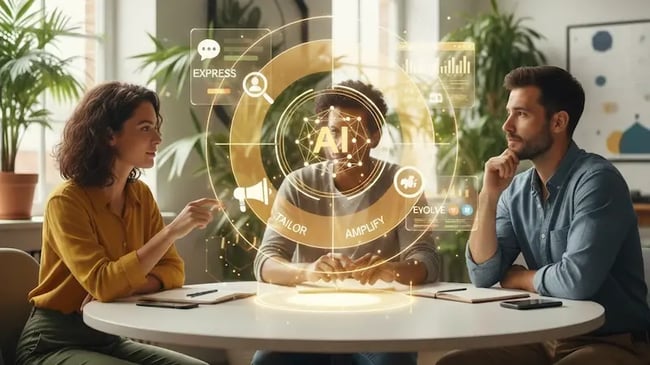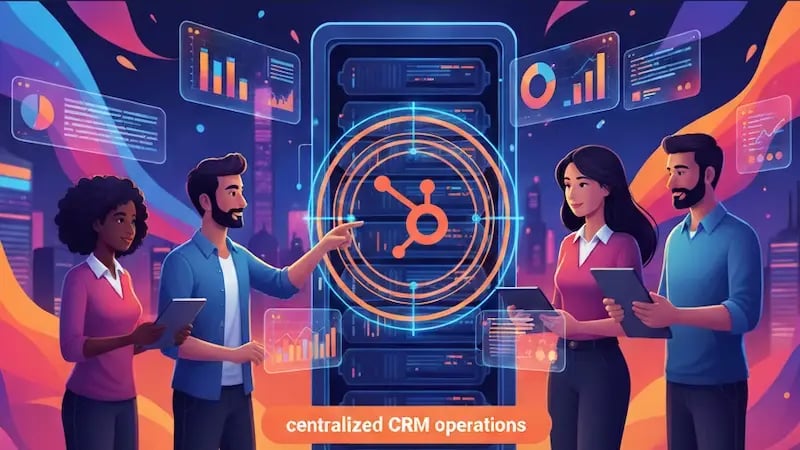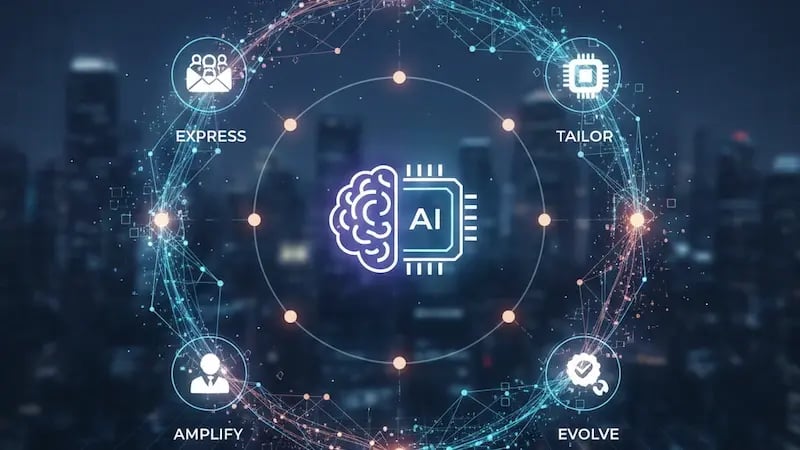Loop Marketing: The AI Playbook for Self-Driving Growth
Master the definitive framework for growth in the AI era. Replace that old linear marketing funnel with an AI-powered, data-driven Loop. This ensures your brand learns faster than the market to build a predictable, growth engine for getting and retaining customers.

The old ways of marketing-the traditional funnel and slow campaigns—just don't work for long-term growth anymore. Today's customers don't follow a simple path. They skip steps, research with AI, and use many different channels from social media like TikTok or Instagram to online communities.
The market is changing fast, and Generative AI is one reason. This speed means that long, traditional campaigns can't keep up. To succeed, your business needs a system that does more than just find customers; it needs to engage them. It must learn and adjust in real time, making every interaction better than the last.
I. Loop Marketing: A New Engine for Sustainable Growth
Loop Marketing is an innovative, flexible plan that replaces the leaky, one-time funnel with a continuous cycle of keeping and growing customers. Pioneered by HubSpot, Loop Marketing draws inspiration from the infamous flywheel; each stage feeds into the next.
In a traditional marketing framework, a campaign typically ends after a sale. Mission accomplished, right? Not really. The Loop never stops. Every customer interaction gives you data that makes the next step better. This creates growth that builds on itself and dramatically improves your results.
Let's put it like this:
-
Traditional Funnel: A linear path that ends at the point of purchase. Once a customer buys, they "fall out" of the funnel.
-
Loop Marketing: A continuous cycle where every customer interaction feeds into the system, from a first visit to post-sale feedback. The role of Loop Marketing is to make the next cycle smarter, leading to compounding acquisition, retention, and accelerated growth.
This playbook uniquely blends the best of two worlds: human strategy and real creativity with the speed and power of AI.
The Loop Marketing Concept
Loop Marketing is a continuous, four-stage framework that ensures your brand is always learning, always relevant, and always moving forward. The four stages are:
-
Express: Define your unique brand voice for people and AI.
-
Tailor: Give highly personal and useful messages at scale.
-
Amplify: Share your content widely across new and emerging channels.
-
Evolve: Track results, predict outcomes, and change your plan instantly.
It's a never-ending cycle (Express →Tailor → Amplify → Evolve) that constantly gets smarter.
Why Why Loop Marketing and Why Now? The World is Changing
The move to Loop Marketing is essential. It's how businesses must react to the fast changes happening online:
AI and Zero-Click Results
AI tools like ChatGPT and Google's new Search Generative Experience (SGE) often answer questions right on the search page.
About 60% of Google searches now end with no clicks to any website. Experts predict that by 2028, businesses will lose 50% or more of their free search traffic because of AI search tools.
Your strategy must focus on being cited and recommended, not just ranked.
Less Search Traffic
Websites in the U.S. are seeing an average drop of nearly 60% in organic search traffic.
Having great website content isn't enough when AI overviews take up so much space on the search page.
Higher Quality Buyers
While you might get fewer overall visitors, the people who visit your website are often much closer to buying. These are "AI-assisted buyers." They've already done much research, so they arrive knowing what they want.
Traffic that comes from AI tools converts 4.4 times better than regular search traffic.
You must make every interaction count.
Complex Buyer Journeys
Customers use many different platforms to find brands. Your marketing needs to meet them on social media, video sites, and chatbots and connect all that data.
II. The Changing Framework: From Funnel to Loop
The move from the Sales Funnel to Loop Marketing is a huge shift in how a business thinks—from simple, straight-line thinking to flexible, cyclical growth.
1. The Broken Funnel (Awareness → Purchase)
The classic marketing funnel (Awareness, Consideration, Decision) made sense when the market was simpler. Now, its limits are huge problems:
-
It Stops at the Sale: The funnel treats the customer journey as a one-way trip. Once the purchase is done, the process ends. They've made their decision.
-
It Only Focuses on New Buyers: The Funnel mostly worries about finding new customers. It often forgets about keeping and growing existing customers, forcing you to always chase new leads.
-
It Fails with AI Buyers: The funnel assumes a prospect needs to learn on your website. Today, buyers often enter the process well-informed by AI, skipping the early stages.
The problem is that funnels leak, leads go cold, and the valuable data created is rarely used to improve the next campaign.
2. The Flywheel vs. The Loop: The Next Evolution
Many businesses adopted the Flywheel model when the funnel failed.
-
The Flywheel's Strength: The Flywheel is a good idea. It focuses on the customer and shows how happy customers help you grow through referrals and repeat business. It rightly puts a high value on keeping customers.
-
The Loop: The Next Evolution: The Loop uses the Flywheel's idea, but adds a key part: learning and adjusting right now. It's not just about speed; it's about getting smarter every time it spins. The Loop adds the Evolve stage. This stage utilizes AI to continually enhance the entire system.
3. The Compound Effect: Growth That Builds on Itself
The Loop is designed to make your efforts build on themselves. Every trip through the four stages makes the whole system stronger:
-
Data Makes You Smarter: Data from the Evolve stage (e.g., "AI-optimized content converts 4.4× better") is instantly sent back to the Express and Tailor stages.
-
Better Targeting: This data sharpens your Ideal Customer Profile (ICP), ensuring clearer Express stage messages and spot-on Tailor stage targeting.
-
Competitive Edge: You learn faster than your rivals. Each cycle makes your content more useful, your targeting more accurate, and your spending more efficient. This constant learning and applying of knowledge builds a huge competitive advantage.
III. The Four Stages of Loop Marketing
The four stages of Loop Marketing work together as one continuous, innovative process.
A. Stage 1: Express (Define Your Authenticity)
The first step is a human-centered strategy: locking in your unique brand story. When AI can produce endless amounts of content, being real is more important than being loud.
What happens in the Express Stage?
The Express Stage is where you clearly define your brand's unique identity, voice, and positioning. This step ensures that everything you communicate—no matter who or what makes it—sounds exactly like your brand.
The Human Element: The New Differentiator
Since everyone can use the same AI tools, the real difference lies in the quality of the human input. If you give AI basic instructions, you get basic content. The Express stage must be driven by human creativity and judgment. You decide: are you bold and challenging, or calm and trusted? This choice becomes the "rulebook" for your AI tools.
Key Activities
-
Defining the Ideal Customer Profile (ICP): You must know exactly who needs to hear your message. Use your data to find your most profitable customers. Define their goals and problems with high accuracy.
-
Creating the Brand Style Guide for AI: This is more than a standard style guide. It's a full document that tells AI your brand's values, tone of voice, and personality. This prevents AI from creating bland, forgettable content.
-
Generating Campaign Concepts: Use tools to quickly brainstorm ideas that fit your new brand identity and truly solve your audience's core problems.
B. Stage 2: Tailor (Make it Personal, Not Generic)
Once your message is clear (Express), you must deliver it with high relevance. The Tailor Stage moves from surface-level personalization to genuine, contextual engagement.
What happens in the Tailor Stage?
The Tailor Stage uses all your customer data, along with AI signals, to give highly personal and useful experiences to many people at once. It makes customers feel truly understood.
Beyond Personalization: Contextual Relevance
Buyers expect relevance that proves you get their situation. True tailoring goes beyond simply inserting their name in an email. It uses every data point—which ads they clicked, which pages they visited—to deliver exactly what they need right now. For example, if a prospect visits your pricing page three times this week, your tailored message should instantly offer a relevant case study or a personalized demo, not just a standard newsletter.
Key Activities
-
Using Unified CRM Data: Your CRM is the heart of this. It must collect every interaction: emails opened, ads clicked, and service tickets. AI then looks at this data for signs of high intent (e.g., repeatedly viewing a purchase page).
-
Creating "Cohort of One" Personalization: Instead of sending the same email to a huge list, AI helps you treat each customer individually. This lets you reach out with messages based on what they are doing right now.
-
Implementing Dynamic Content: Use technology to automatically change your marketing pieces. Website sections, emails, and calls-to-action (CTAs) should change based on the viewer's job, industry, or where they are in the buying process. This speeds up the sale by making the path from interest to purchase clear.
C. Stage 3: Amplify (Be Discoverable Everywhere)
Once you have an authentic (Express) and relevant (Tailor) message, the Amplify Stage ensures your message reaches buyers across all channels.
What happens in the Amplify Stage?
The Amplify Stage is about getting your content everywhere your customers are. This means going beyond your website to reach buyers in many places. It also ensures that your content can be found by people and AI search tools.
AEO (AI Engine Optimization): The New Search Battleground
Since so many searches end with no clicks, just ranking high (SEO) is not enough. You must focus on AEO (AI Engine Optimization). This is the key shift from trying to rank to making sure AI search tools cite you and use your answers. Your goal is to be seen by the AI as the most trusted source of information.
Key Activities
-
Optimizing Content for AI Models: Structure your content (use direct questions and answers, and provide clear summaries) so that AI models can easily find quick, accurate facts for their responses. This raises your visibility in AI search.
-
Diversifying Content Formats: Take every piece of core content and turn it into many formats. An article can become an AEO-ready summary for ChatGPT, a short vertical video for TikTok, and a carousel graphic for LinkedIn.
-
Partnering with Trusted Creators: When there is so much AI-generated content, people trust real human experts. Working with creators in your field helps build trust and gets your brand into the conversations your audience already has.
-
Targeted Ad Activation: Use your rich CRM data to run smart ads. Place personalized messages into the social feeds and online spaces where your highest-intent prospects spend time.
D. Stage 4: Evolve (Learn Fast, Act Faster)
The Evolve Stage is the dynamic heart of Loop Marketing. It helps your business not only keep up but also get ahead. By quickly changing your plan, you turn every marketing effort into a learning chance that makes your insights build on themselves.
What happens in the Evolve Stage?
The Evolve Stage is a live feedback system. It uses AI to track how things are going, guess future results, and make instant changes. This makes your marketing faster, smarter, and cheaper every time.
Real-Time Optimization: Experiments Over Campaigns
The market changes constantly. What worked six months ago might not work now. This means you must switch from planning long, rigid campaigns to running quick experiments. You learn from them in just a few days. The Evolve stage is about learning fast and acting even quicker. You can't wait for a quarterly report to see what happened.
What You Do in the Evolve Stage
The Evolve Stage involves several steps, all focused on using AI and real-time data to constantly improve your marketing:
-
Simulate Campaign Outcomes: Before you launch, use AI tools (like Email Engagement Optimization) to predict which customers will likely respond. You can find and fix weak points before you start.
-
Monitor in Real Time: Once campaigns are running, track their results as they happen. AI highlights anything unusual (a sudden drop or surge in clicks) so you can react fast. Tools like Smart Digest can spot early trends and alert you immediately.
-
Run Rapid Experiments: The Evolve stage pushes you to run fast A/B tests on things like headlines or offers. AI gives you instant insights to quickly find what works best. For example: "Which ad version got the most purchases from B2B buyers in Group A? Tell me why."
-
Refine Strategy Continuously: This is the key step. You take what you learned and immediately use it to improve the Express and Tailor stages. Every small change you make makes your next campaign clearer, faster, cheaper, and harder for others to copy. This data-driven refinement is crucial for long-term success.
Measuring Success: Focus on Velocity
When you use the Evolve stage, velocity is the main way to track success. This means checking how quickly and effectively you adjust your tactics to make each new cycle better than the last.
Key things to measure are:
-
Loop Velocity: The number of experiments you run each month. A higher number means you learn and adapt faster.
-
Pipeline Velocity: How quickly potential customers move through your sales process. Continuous improvement makes this speed up.
-
Qualified Leads Generated: If your changes are working, the number of high-quality leads should consistently go up.

IV. Implementation & HubSpot Tools
Loop Marketing needs a strong operating system to succeed, especially with integrated data and tools.
1. The Foundation: Unified CRM Data
For the Loop to work, it needs a single, reliable source of information. You need a Unified CRM that combines every team and channel data point to build a complete customer story.
-
If you don't use a unified CRM, the loop breaks. Your teams won't have the full customer story they need to correctly Tailor messages and Evolve strategies.
-
This system ensures that if a customer files a support ticket, Marketing immediately knows about it. They can then avoid sending that customer an irrelevant promotional email.


2. The AI Layer: Enabling Scale and Speed
The Loop works because humans and AI work together. AI handles the hard parts—analyzing data, running tests, and creating first drafts—so your human marketers can focus on high-level strategy.
-
HubSpot AI Features (Examples): Tools like HubSpot's Breeze Assistant can use your data to find customer insights and write campaign ideas (Express). Marketing Studio helps you quickly create content and dynamic pages (Tailor & Amplify).
-
The Partnership: AI makes the Loop run fast; the human marketer gives the wisdom and strategic oversight to make sure the Loop runs in an honest, authentic way.
3. Internal Alignment: Breaking Down Silos
The Loop removes the walls between different departments. Growth is not just Marketing's job; it's a team effort:
-
Service → Marketing: Customer Service insights (what customers complain about) go back to improve the Express stage content. This ensures marketing materials directly address customer questions.
-
Sales → Marketing: Sales data (which leads closed fastest, which pitch worked best) goes back to improve the Tailor stage targeting and lead scoring.
-
The Shared Goal: All teams use the same CRM data and shared language. This ensures a smooth and consistent experience for the buyer.

V. Starting Loop Marketing
1. Recap: The Future is Here
The Evolve stage is the final step, but in this continuous cycle, it's also the start of the next one. Loop Marketing is how businesses must grow in the world of AI. It replaces the old, leaky funnel with a system that improves marketing with every cycle, building a strong competitive advantage.
HubSpot customers using this approach are already seeing huge wins:
-
129% more leads
-
A 37% faster time to solve customer problems in just one year.
Loop Marketing is not just a theory; it's a powerful way to grow your business.
2. Next Steps: Start Building Your Loop
The time to act is now. The market is not waiting; it is changing daily. The best way to beat your competition is to start learning and adapting faster than they do. Every day you delay, you miss out on compounding data and higher-quality conversions.
The Loop is flexible—you don't have to overhaul everything simultaneously.
Start small: Identify your most significant challenge (e.g., Express if your messaging is generic, or Tailor if your data is siloed) and focus your first experiment there. By concentrating on velocity over perfection, you turn today's effort into tomorrow's strategic advantage.
Loop Marketing - Frequently Asked Questions
Loop Marketing is a modern plan for growth. It moves away from the old marketing funnel and uses a continuous cycle of customer actions. It cleverly mixes human strategy (being authentic) with AI efficiency (fast data analysis) to make growth happen faster and better.
The main difference is that the Funnel is a straight line that ends once you make a sale. The Loop is continuous and keeps building. Every time you talk to a customer—even after they buy—it gives you data that improves the system, helping you grow by keeping and expanding customers.
The Loop has four steps that happen in a circle:
-
Express: Define your unique brand story for everyone to follow.
-
Tailor: Use data to give customers highly personal and useful messages.
-
Amplify: Share your content widely, making sure AI search tools can find it.
-
Evolve: Track your results, guess outcomes, and change your plan instantly using AI.
The Express stage is key because it sets your brand's unique voice and personality. Since AI can create endless content, your human-defined voice is the only thing that will make your brand stand out and keep your content from being bland or generic.
Contextual relevance means sending a message that shows you truly understand the customer’s exact needs right now. It goes beyond simple personalization (like using their name). It uses unified data to tailor content based on what they are currently doing or looking at.
AEO (AI Engine Optimization) is the new way to approach search. Since AI search often gives direct answers without clicks, you can't just try to rank high (SEO). AEO means creating and organizing your content so that AI models trust your information and choose to cite you when answering user questions.
The Evolve stage stops you from waiting for slow reports. It uses AI to:
-
Guess campaign results before you launch.
-
Watch live performance to spot problems right away.
-
Improve your plan instantly by running quick tests and using the new lessons to start the next cycle smarter.
A Unified CRM is the foundation. It gathers all customer data from marketing, sales, and service into one place. Without this, the loop breaks because teams lack the full customer story they need to create accurate, smart messages and plans.
No, Loop Marketing is the next step after the Flywheel. The Flywheel is a good idea that shows how happy customers create momentum. The Loop is the active plan (Express, Tailor, Amplify, Evolve) that uses AI and real-time data to help you continuously run and accelerate that momentum.
The latest on Loop Marketing
- November 5, 2025
- Paul
- October 9, 2025
- Paul






.webp?width=370&height=250&name=Evolve%20(1).webp)